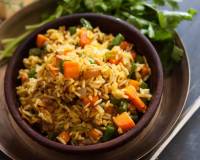Dietary Fibre is a common term used in food which is a type of carbohydrate that we consume on a daily basis. Anything eaten at the right proportion is beneficial for our body, so therefore dietary fibre when consumed at right amount will help to provide certain health benefits.
The consumption of dietary fibre depends on the age and gender. Men who are 50 and less can consume about 38 grams per day, and for men above 50 years of age are advised to consume only 30 grams per day. For women who are at 50 and less can consume about 25 grams per day and for 50 years and above are allowed to get at least 21 per gram.
As mentioned earlier, fibre are carbohydrates which is found in plants. While most of the carbohydrates are broken down into sugar in our body, fibre on the other hand stays intact and passes through your digestive system.
There are two types of fibre which is classified into:
- Soluble – These get easily dissolved with water and form a gel like material. It helps to lower cholesterol and blood glucose level. Soluble fibre are found in oats, peas, beans, apple, citrus fruits, carrots and barley.
- Insoluble – These do not get dissolved in water. They promote the movement of materials in the digestive system and eases constipation problems. These are found in whole wheat flour, wheat bran-nuts, vegetables and beans.
The Health Benefits for consuming the right amount of dietary fibre are:
- Eating dietary fibre rich food aids in digestion and the absorption of nutrients.
- Dietary Fibre will reduce the risk of coronary heart disease and Type-2 diabetics.
- Adding whole-grain dietary fibre in your healthy diet will help to help to regulate blood cholesterol level.
- Adding High Fibre food will make you feel more bulky thus making it more likely for you to eat often and helps you to lose weight.
- Fibre helps to prevent gallstones and kidney stone formation.
5 Ways you can add Dietary Fibre into your everyday diet:
1. Use it as add ons to your everyday meal
Adding Chia seeds to your Breakfast smoothies or to your freshly tossed salad is a great Idea. Or even adding freshly chopped fruits, coconut flakes or some toasted nuts onto your oatmeal will not only add extra crunch to the dish but it is also a best way to sneak in extra fibre.
2. Choose Brown Food (Whole Grains) over White (Refined Grains)
Refined grains are those which are stripped of with vitamin containing-germ and fibre-rich hull. You can replace brown bread or whole grain cereals over white bread, choose brown rice, quinoa, millet, barley or bulgur wheat over plain white rice.
3. Adding Whole Fruits & Vegetables as part of your healthy eating habits
You can snack on freshly cut fruits and vegetables instead of junk food. Make sure the vegetables and fruits are freshly cut and not juiced. Also it is good to eat the peel as well as skin is where it has got highest concentration of fibre. It is healthy tip to eat the veggies first before your main meal as it is fill up your stomach and does not make you overeat.
4. Swap in with more Fibre-Friendly foods
Using substitution like ground flax feel powder as flax meal replacer instead of eggs in your baking is great idea to incorporate fibre into your food. You can add cauliflower into making a white sauce as well and toss it over any pasta of your choice.
5. You can go Meatless
You can get enough protein from these fibre enriched plants like lentils and beans instead of meat. If going meatless and switching to only plant based diet is difficult then you can at least try for a week and see the changes.
























